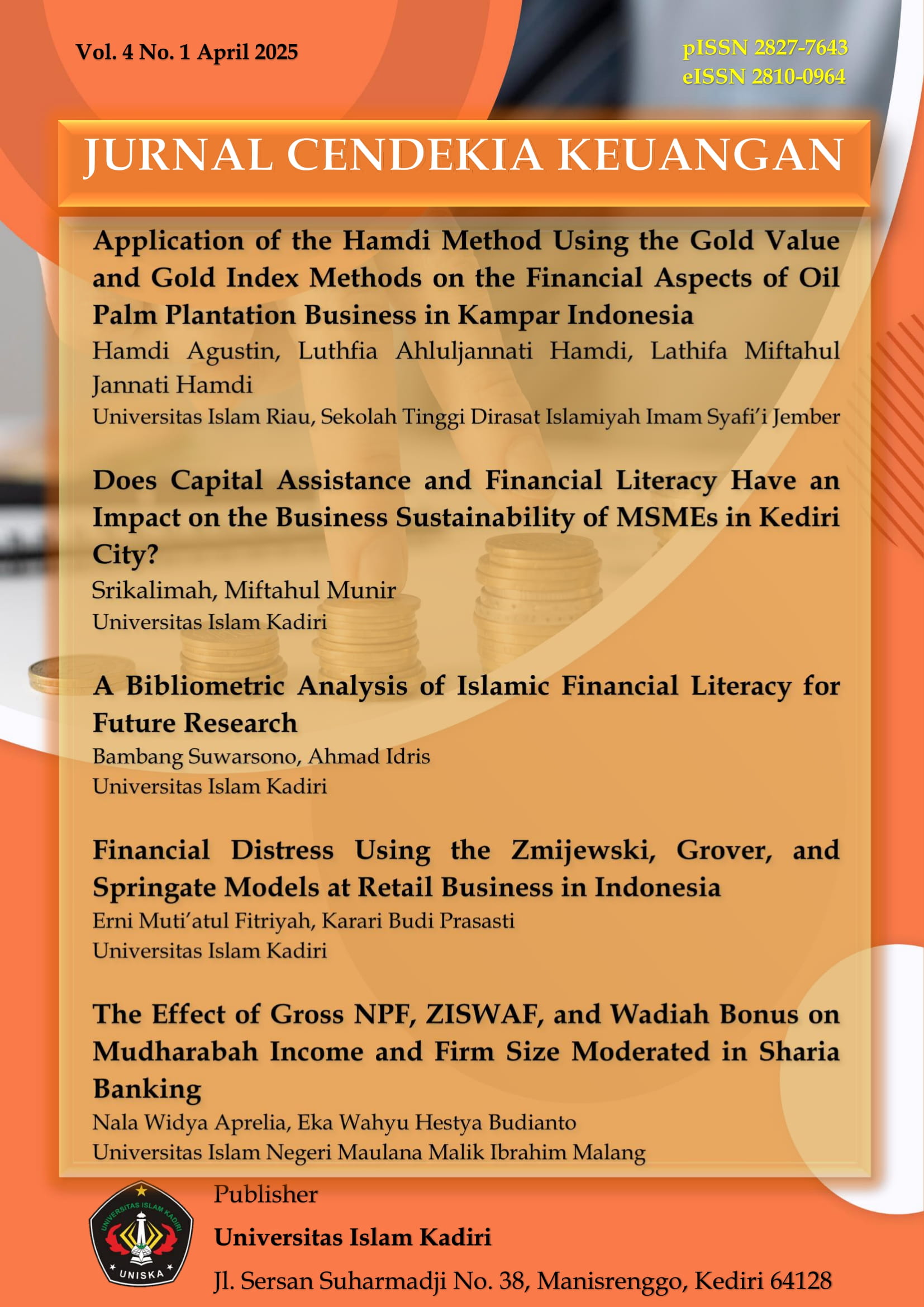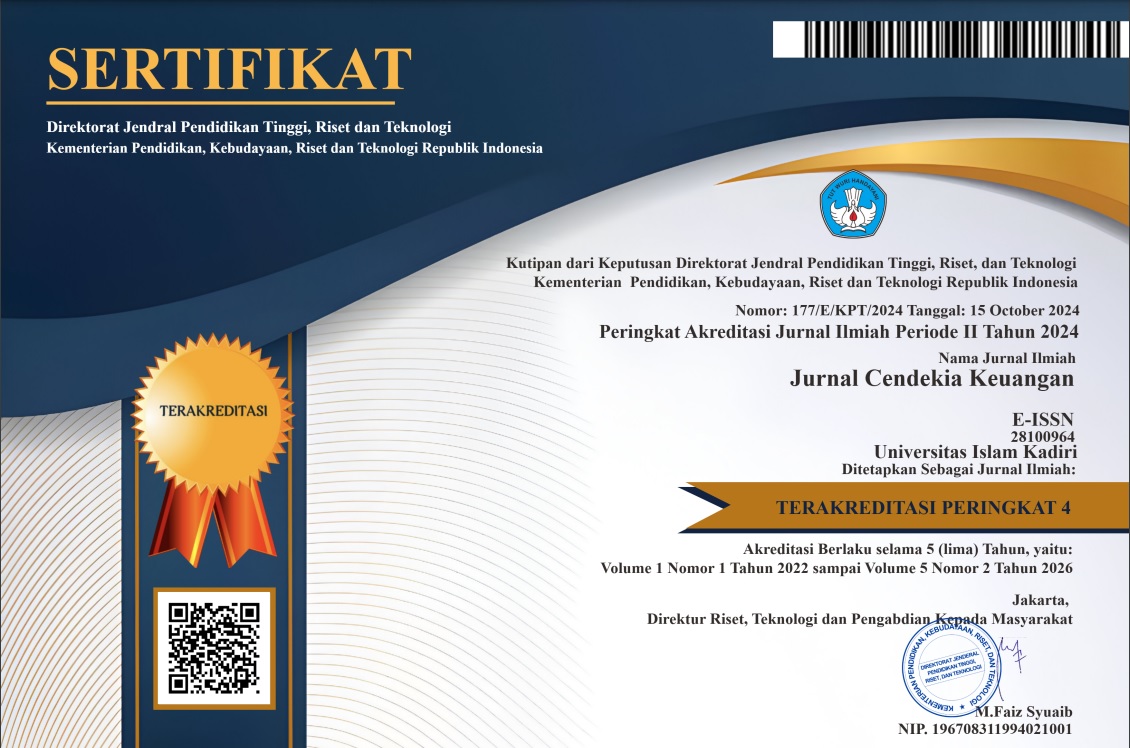Application of the Hamdi Method Using the Gold Value and Gold Index Methods on the Financial Aspects of Oil Palm Plantation Business in Kampar Indonesia
Abstract
Introduction/Main Objectives: This study aims to test whether the assessment of the business feasibility study with the Hamdi method consisting of Gold Value Method (GVM) and Gold Index (GI) gives the same decision results as the assessment using the conventional method consisting of Net Present Value (NPV) and Profitability Index (PI). This research tries to test Mr. Zulkifli's oil palm plantation business plan in Kampar Riau. The results of this assessment will be useful as a consideration in making business development decisions. Background Problems: NPV is not used is the prohibition of interest, which is applied in both Islam and Christianity. Riba or riba refers to the charging of interest at any level, whereas modern beliefs impose interest at an unfair and disproportionate rate and develop in parallel with the periodic interest gain. Novelty: The Hamdi method presents a viable option for assessing the feasibility of a business from a financial perspective and contributes to the calculation methods that exist in this domain. Research Methods: This study uses descriptive and quantitative analysis of the feasibility of Mr. Zulkifli's oil palm plantation business, which is assessed based on conventional and sharia aspects. The feasibility analysis assessment is based on the conventional perspective, namely NPV, and PI. The feasibility assessment is based on Hamdi's Method, namely the GVM and the GI Method. Finding/Results: The findings show that the results of the feasibility decision using GVM are in line with the NPV calculation, and the results of the feasibility decision using GI are in line with the PI calculation. Conclusion: Hamdi's method is feasible for assessing the feasibility of a business from a financial aspect. Research limitation/implications: Hamdi's method is still not well-known and needs to be introduced to other researchers.
References
Agustin, H., Almuttaqin, M. A., Yusnita, R. R., & Safitri, N. (2023). Analyzing Business Feasibility: A Comprehensive Study Using Hamdi's Method. Journal of System and Management Sciences, 13(4), 521–534.
Alam, M. N. (2024). The prohibition of "riba" in Islam and its elimination through "Islamic financing technics." In The Law of Riba in Islamic Banking (pp. 27–57). Routledge.
Bogataj, D., & Bogataj, M. (2019). NPV approach to material requirements planning theory–a 50-year review of these research achievements. International Journal of Production Research, 57(15–16), 5137–5153.
Diniaty, D., Fauzi, A. M., Sunarti, T. C., Raharja, S., & Helmi, F. (2024). DETERMINATION OF SUPERIOR COMMODITIES FOR THE DEVELOPMENT OF SMALL AND MEDIUM INDUSTRIES IN KAMPAR REGENCY. Journal of Applied Engineering and Technological Science, 5(2), 995–1010. https://doi.org/10.37385/jaets.v5i2.4727
Dobrowolski, Z., & Drozdowski, G. (2022). Does the net present value as a financial metric fit investment in green energy security? Energies, 15(1), 353.
Erwinda, E., Hati, D. P., Mulyani, A., & Nugroho, E. S. (2021). An estimation method for oil palm replanting potential in kampar regency, province of riau. IOP Conference Series: Earth and Environmental Science, 757(1). https://doi.org/10.1088/1755-1315/757/1/012034
Gürak, H. (n.d.). The NAS is there! President Erdoğan's economic instrument to fight inflation. In The Law of Riba in Islamic Banking (pp. 89–103). Routledge.
Gürak, H. (2024). Is there a "divine" definition of riba and its scope in the Holy Quran? In The Law of Riba in Islamic Banking (pp. 58–70). Routledge.
Gürak, H., & Hatti, N. (2024). The Law of Riba in Islamic Banking. Routledge.
Husni, H., & Sugiarto, F. (2024). Interpretation of Riba Verses in Ibn Kathir's Tafsir (Comparative Studies in the Tafsir of Ibn Katsīr and Al-Marāghī). Jurnal Kajian Islam, 1(1), 18–23.
Iqbal, M. M., & Shah, A. (2024). A Probable Reason for Qur'anic Prohibition of Riba: Dissimilarity of Price and Interest Rate as Equilibrating Variables. Islamic Studies, 63(2), 241.
Islam, M. S., Kamarulzaman, N. H., Shamsudin, M. N., Nawi, N. M., Alam, M. J., & Bhandari, H. (2024). Economic Impact and Returns on Investment of Rice Research and Extension in Bangladesh: An Economic Surplus Approach. Journal of Hunan University Natural Sciences, 51(6).
Ismal, R. (2022). Identifying the Optimal Cash Waqf Linked Sukuk : Indonesia Experience. Hamdard Islamicus, 45(3), 9–27. https://doi.org/10.57144/hi.v45i3.500
Istan, M. (2023). Implementasi Investasi Emas: Kajian Teoritis dan Praktis Menurut Ekonomi Islam. Al-Intaj: Jurnal Ekonomi Dan Perbankan Syariah, 9(1), 1–12.
Khan, M. A. (2024a). Conclusion to Islamic Economics and Human Well-being. In Islamic Economics and Human Well-being (pp. 246–256). Edward Elgar Publishing.
Khan, M. A. (2024b). Investment decisions and social justice. In Islamic Economics and Human Well-being (pp. 133–145). Edward Elgar Publishing.
Khan, M. A. (2024c). Justice in finance: prohibition of riba. In Islamic Economics and Human Well-being (pp. 109–132). Edward Elgar Publishing.
Knoke, T., Gosling, E., & Paul, C. (2020). Use and misuse of the net present value in environmental studies. Ecological Economics, 174, 106664.
Kuckartz, B. T., & Peroni, R. L. (2019). NPV analysis of multiple expansion scenarios under surface constraints for pit geological uncertainty. REM - International Engineering Journal, 72(2), 293–300.
Li, Q., Li, Q., Xu, D., & Zhou, S. (2022). A Systematic Literature Review on the Traditional NPV Model and Its Improved Versions. 2022 7th International Conference on Financial Innovation and Economic Development (ICFIED 2022), 2487–2492.
Lilford, E., Maybee, B., & Packey, D. (2018). Cost of capital and discount rates in cash flow valuations for resources projects. Resources Policy, 59, 525–531. https://doi.org/https://doi.org/10.1016/j.resourpol.2018.09.008
Liu, Q. (2022). Sensitivity analysis and investment decision making under uncertainty based on NPV method. 2022 7th International Conference on Financial Innovation and Economic Development (ICFIED 2022), 1861–1865.
Magni, C. A., & Marchioni, A. (2020). Average rates of return, working capital, and NPV-consistency in project appraisal: A sensitivity analysis approach. International Journal of Production Economics, 229, 107769.
Mollah, A. S., Rouf, A., & Rana, S. M. S. (2023). A study on capital budgeting practices of some selected companies in Bangladesh. PSU Research Review, 7(2), 137–151. https://doi.org/10.1108/PRR-10-2020-0035
Poonam, M., & Aneja, D. H. (2018). Challenges and Impact of Capital Budgeting Techniques- An Empirical Study (Only Automobiles Companies). RESEARCH REVIEW International Journal of Multidisciplinary, 3(12), 939–945.
Purnomo, H., Okarda, B., Dermawan, A., Ilham, Q. P., Pacheco, P., Nurfatriani, F., & Suhendang, E. (2020). Reconciling oil palm economic development and environmental conservation in Indonesia: A value chain dynamic approach. Forest Policy and Economics, 111. https://doi.org/10.1016/j.forpol.2020.102089
Sabri, S. R. M., & Sarsour, W. M. (2019). Modelling on stock investment valuation for long-term strategy. Journal of Investment and Management, 8(3), 60–66.
Sokolov, M. V. (2024). NPV, IRR, PI, PP, and DPP: A unified view. Journal of Mathematical Economics, 114. https://doi.org/10.1016/j.jmateco.2024.102992
Sulaeman, M. (2024). Islamic Public Finance Analysis: A Scholarly Review Of Islamic Legal Perspectives. IQTISHOD: Jurnal Pemikiran Dan Hukum Ekonomi Syariah, 3(1), 28–44.
Syarif, F., Kurniawan, M., Ahmadi, H., & Setiawan, P. R. (2023). Stabilization of Peat Soil with Vegegrout. International Journal of Sustainable Construction Engineering and Technology, 14(4), 94–102. https://doi.org/10.30880/ijscet.2023.14.04.08
Xiao, D., Liu, M., Li, L., Cai, X., Qin, S., Gao, R., Liu, J., Liu, X., Tang, H., & Li, G. (2023). Model for economic evaluation of closed-loop geothermal systems based on net present value. Applied Thermal Engineering, 231, 121008.

This work is licensed under a Creative Commons Attribution-ShareAlike 4.0 International License.














